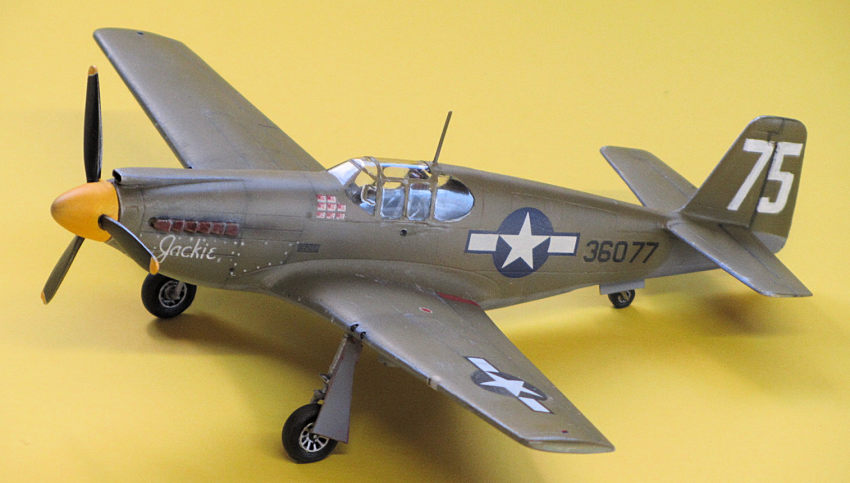
High Planes 1/72 P-51A Mustang
| KIT #: | 72015 |
| PRICE: | $20.00 |
| DECALS: | Three options |
| REVIEWER: | Ryan Grosswiler |
| NOTES: | Short-run injection molded, resin and white metal parts |

| HISTORY |
If one
has any sector of his mind marked out under the Human History heading,
then he can probably conjure up a few images of airplanes that had some
effect on the story of our species, particularly in That Last Big One. If he
can think up of any airplanes in particular, usually things filed as "the
Wright Brothers Airplane", "Fokker Triplane", and "Spirit of St.
Louis", will come up, along
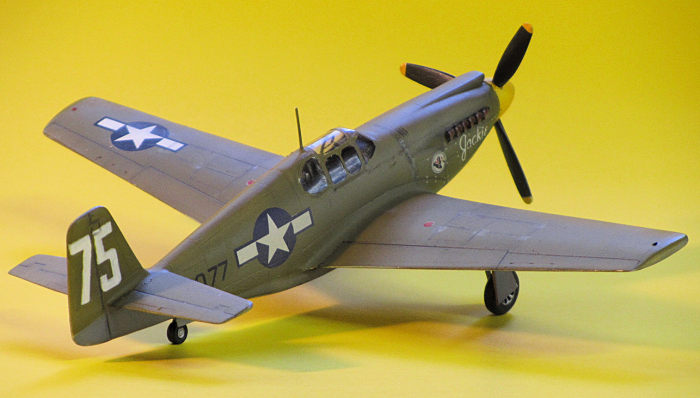 with
"Spitfire", "Japanese Zero", " the Stuka", "B-17", "Corsair",
"Messerschmitt" "747" and "the Concorde" (without the definite article if
you live in the UK).
with
"Spitfire", "Japanese Zero", " the Stuka", "B-17", "Corsair",
"Messerschmitt" "747" and "the Concorde" (without the definite article if
you live in the UK).
Then there was this one: "P-51 Mustang"
The
mental picture will invariably pop up as a 'D' model, however.
Prettier, with that shiny natural-metal skin and bubble canopy, it gets the
spotlight as owning one remains a status symbol among aviation-minded A-list
film actors and the newly uberwealthy. There's that whole Victory in Europe
air about it, and the 'definitive version' as well. All of which leaves the
homely, olive-drab 'A' version modeled here consigned to the consciousness
of only those interested in the truly esoteric. It also implies that this
was the 'inferior' version.
Not so.
According to the late (because he died test-hopping a P-38 in 1997), great
(because he was a supernice guy when my buddy and I met him at Chino in the
'80s, treating us warmly as equals and not the teenage airport vermin that
we were) Jeff Ethel, the P-51A was more like a stripped down-drag racer,
lighter and faster off the line than its successor. It may not have had the
performance up high that it needed for the air war over western Europe, but
it did very well in the low altitudes over the jungles of So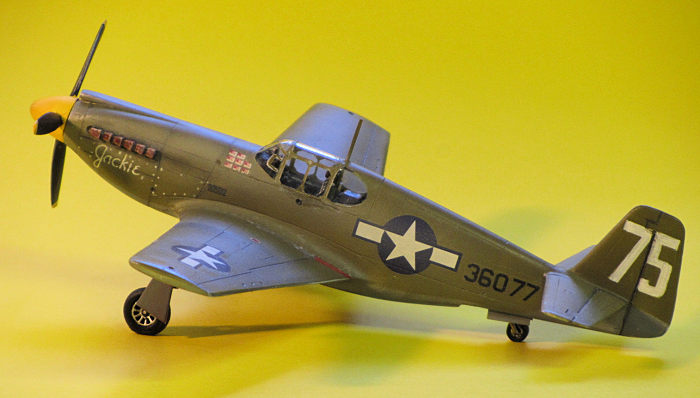 uth/South-east
Asia and the deserts of Africa. More importantly, while that D was only at
the front lines for the last year or so, it was this first version which was
in action constantly from Spring 1942 on through all the way to the end of
the war.
uth/South-east
Asia and the deserts of Africa. More importantly, while that D was only at
the front lines for the last year or so, it was this first version which was
in action constantly from Spring 1942 on through all the way to the end of
the war.
The Soviets received about ten from RAF stocks, and many more -Cs and -Ds later, but used them only for training and test. It's interesting to note that the Russians didn't care much for this most iconic of American warplanes in any of its forms, finding it under-maneuverable, under-armed, and blessed with a performance at altitude for which they had little use.
As for the lowly A, it gained one more distinction: being the model of Mustang with the longest uninterrupted combat service, beating the D's three years in Korea by a few months.
| THE KIT |
For a long time we had only the old but fairly respectable Frog kit to serve us the Allison Mustang in 1/72. In the late '90s, however, this was one of the subjects that suddenly seemed to get the Almighty's Lightning Bolt Of Attention, with kits in 1/48 and 1/72 coming out from at least five different manufacturers. High Planes' was the first one of that gaggle to appear on the market.
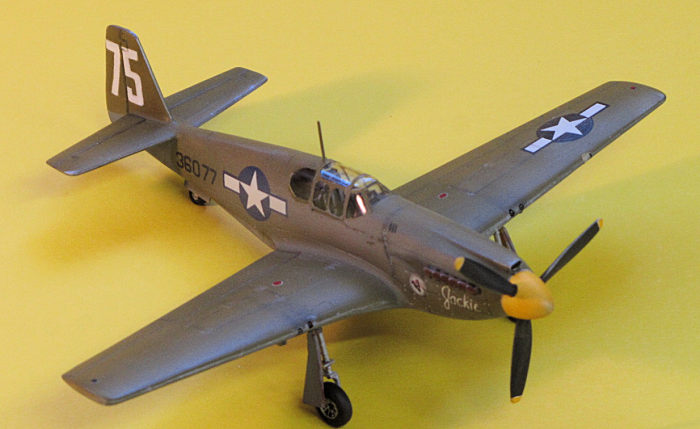
Two sprues of light-blue plastic make up most of the contents. It's all very '90s short-run stuff here: heavy gates, lots of flash, but a truly beautiful little kit that emerges when you extract it from that mess (as I prepped this kit, I kept thinking about Sigourney Weaver freeing little Newt from that yucky xenomorph nest at the end of Aliens). In their time of original ownership, High Planes suffered from some pretty unfair (and sometimes downright mean) reviews, and I wondered if it had something to do with the cottage-industry presentation of the contents because all their kits I've built were actually quite nice once you got going on them. Sharply-molded white metal main gear legs, resin radiator scoop and main wheels, plus a superb vac-form canopy from Falcon models round out the package. Decals for three versions, all OD-over-NG, and an exploded-view drawing for assembly guidance.
| CONSTRUCTION |
As stated
above, it all started with cutting loose the main parts, sanding their
mating surfaces, and a general test fit. I cut out and dry-fitted the canopy
at this time, as it's always easier to correct any problem with that
component at this stage. The only problems were the predictable iffy fit at
the wing roots and the need to sand down the interior of the forward edge of
the canopy part, which is nicely
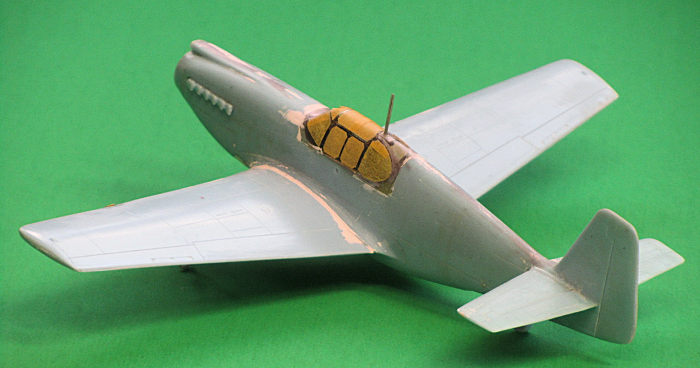 engineered
to include a little bit of fore and aft fuselage as well. I also spent a
little while thinning down the wing trailing edges.
engineered
to include a little bit of fore and aft fuselage as well. I also spent a
little while thinning down the wing trailing edges.
Surprisingly,
this kit has a fairly complete and usable cockpit, including sidewalls. I
used all of it and only added lead-foil seatbelts, a scratchbuilt gunsight,
plus a few assorted bits on the radio shelf. It looked great after the usual
cockpit painting and finishing treatment. The fuselage was closed up, and I
drilled out and fitted my usual brass rod/tube prop shaft assembly and fit
the prop and spinner at the same time. I glued, faired in, and masked the
canopy at this stage.
The
only real challenge on this kit was getting that carburetor intake on top of
the nose (distinct to the "A") properly shaped and hollowed out. The real
thing's a rounded rectangle opening with a slight frowny-face droop to it,
and it's wee in 1/72. Some quality time was spent with my Dremel tool and
the tiniest spherical bit, and I still had to go back and putty-up some
goofs a couple of times. But it's very prominent on the completed model and
I wanted to get it right. High Planes really should have supplied it as a
resin item.
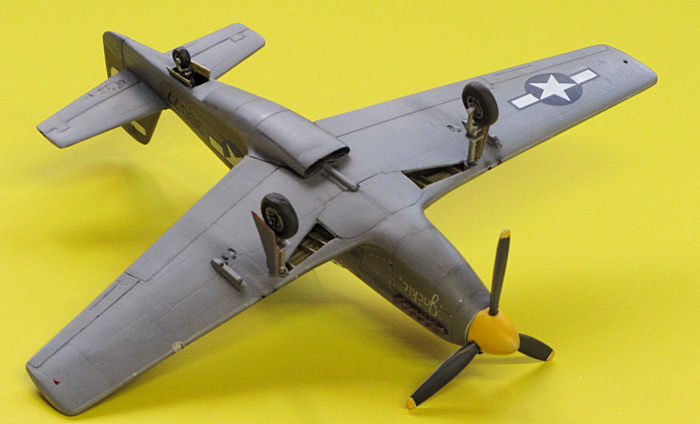 There's also the lack of any mounting provision whatsoever for the landing
gear. I superglued short segments of aluminum tube against the tops of the
wings for the mains and boxed in the tail wheel well to achieve this. The
other special item was the gun openings. The real A featured staggered,
visible gun muzzles 'floating' in larger voids, so I drilled these openings
shallowly at the kit's molded dents, then went in with a smaller bit dead
center. Some spare resin M2 barrels were then slipped into this center hole
and glued.
There's also the lack of any mounting provision whatsoever for the landing
gear. I superglued short segments of aluminum tube against the tops of the
wings for the mains and boxed in the tail wheel well to achieve this. The
other special item was the gun openings. The real A featured staggered,
visible gun muzzles 'floating' in larger voids, so I drilled these openings
shallowly at the kit's molded dents, then went in with a smaller bit dead
center. Some spare resin M2 barrels were then slipped into this center hole
and glued.
I also sprinkled in some sheet styrene wheel-well detail for the mains. Unlike the D, the main doors on the A model stayed up even after hydraulic pressure bled off following shutdown, and High Planes has them correctly molded shut. This little factoid saved me a lot of work!
General assembly followed. No surprises here, just a line of filler at each wing root and a lick here and there elsewhere over the airframe.
| COLORS & MARKINGS |
Olive Drab and Medium Gray were mixed from Testor's square-bottle
enamels, with a bit of yellow and white added to the OD for scale effect.
This was shot over white primer and pre-shading base. A gloss coat of Future
and the decals were next. These were printed sharply and performed well, but
the numerals "75" of Captain England's aircraft were way too skinny--I had
to bulk them up with a little hand-painting. An enamel wash, some fine
weathering, and a pair of exhaust streaks went on and that was about it.
| CONCLUSIONS |
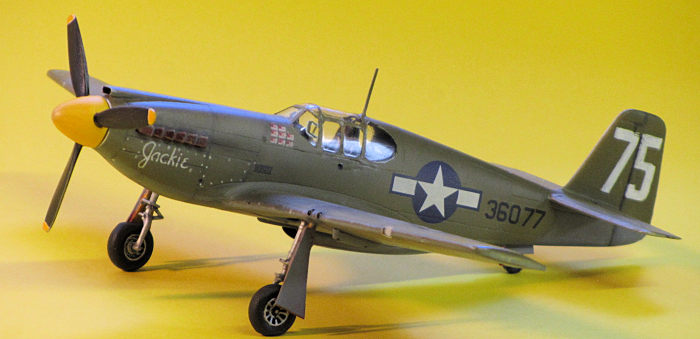 I have no idea how this one stacks up against the other 1/72 P-51As, and
most modellers will opt for the long-run Academy version which also (rather
randomly) gives you a Jeep. But I think this kit's a bit more accurate (they
got the rear-quarter windows right), and it really wasn't that much more
work.
I have no idea how this one stacks up against the other 1/72 P-51As, and
most modellers will opt for the long-run Academy version which also (rather
randomly) gives you a Jeep. But I think this kit's a bit more accurate (they
got the rear-quarter windows right), and it really wasn't that much more
work.
I'm pleased with this neat little model; it looks great next to my old-mold Hasegawa "D".
(P.S.:
In shooting these pictures, I noticed the top of the vertical fin was too
rounded. This isn't a fault of the kit parts; just my overzealous sanding.
It bugged me though, so I brought it back to the bench, glued some tiny
styrene triangles at the top corners and spread a little filler over them.
Then, after letting it dry while my family and I watched a movie, I came
back and sanded it to shape, finishing with a quick retouch of paint. Total
correction time: 15 minutes--and it looks a lot better!)
| REFERENCES |
Davis, Larry. P-51 Mustang in action. Squadron Signal Publications, 1981
Davis, Larry. P-51 Mustang in color. Squadron Signal Publications, 1982 (apparently it was either in action or in color, but never both)
Stanaway, John. Mustang and Thunderbolt Aces of the Pacific and CBI. Osprey Publishing, 1999
April 2017
Copyright ModelingMadness.com
If you would like your product reviewed fairly and
fairly quickly, please
contact
the editor
or see other details in the
Note to
Contributors.
Back to the Main Page
Back to the Review
Index Page
Back to the Previews Index Page